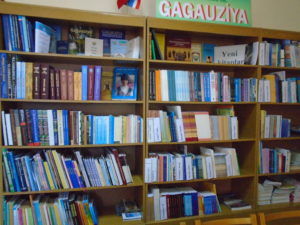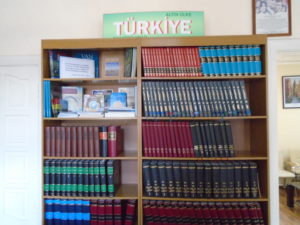Visiting libraries in Moldova
Category: Blog
This is a guest blog post written by Ian McCracken, retired CILIPS member and former Trustee. Ian recently took a trip to Moldova where he was able to visit the National Library of Moldova and also the library in the autonomous region of Gagauzia. Here he writes about this experience and shares some pictures of the libraries he visited.
Visit to Moldova September 2019
by Ian McCracken
 A couple of months ago, I went on a five-day small group tour to Moldova. During the trip, we came across a couple of libraries that I thought others might be interested in reading about.
A couple of months ago, I went on a five-day small group tour to Moldova. During the trip, we came across a couple of libraries that I thought others might be interested in reading about.
After arriving on the excellent Air Moldova on the Saturday evening, our guide, Victoria, greeted us all and we made our way to the excellent City Park Hotel in a charming pedestrianised street in the centre of the capital, Chisinau.
After an early breakfast (an excellent hot and cold buffet which would need a blog on its own to fully describe!) the next morning, we all assembled outside the hotel for a walking tour of the city. Victoria, who turned out to be a superb guide, multilingual and very knowledgeable, explained that the city’s name was pronounced “Kishinaw” –and got us all to repeat it until she was sure we had got it right!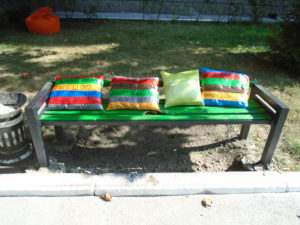
It was a beautiful sunny and warm morning as we made our way along the immaculately clean streets then through the equally well-kept park to the Orthodox Cathedral, where the morning service was just about to start. This led us to the main boulevard, on and around which the principal government and cultural buildings are situated.
Much of the city had been destroyed in the 1940s-a major earthquake and World War Two had ravaged much of the city; however, the new buildings looked impressive – the Parliament, the National Theatre, Opera etc.
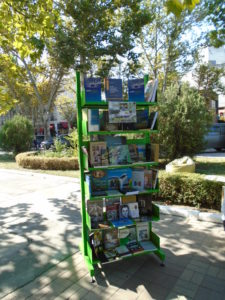 After stopping to hear about each of these, we turned left to see the National Museum. As we walked along, we could hear pleasant light music. We soon found that this emanated from speakers outside the National Library. Curious, we all went into the courtyard where we could see an array of books on display. Victoria enquired of the staff hovering around what was going on. It turned out that this was an imitative entitled “Reading in the open air” or in the local language (Romanian) ”Lecturi en plein air”. This was to encourage locals to make the most of the lovely weather (30 degrees most days) and enjoy the pleasure of reading outside.
After stopping to hear about each of these, we turned left to see the National Museum. As we walked along, we could hear pleasant light music. We soon found that this emanated from speakers outside the National Library. Curious, we all went into the courtyard where we could see an array of books on display. Victoria enquired of the staff hovering around what was going on. It turned out that this was an imitative entitled “Reading in the open air” or in the local language (Romanian) ”Lecturi en plein air”. This was to encourage locals to make the most of the lovely weather (30 degrees most days) and enjoy the pleasure of reading outside.
As you can see, a wide selection of books were available for people to peruse: -fiction and non-fiction; books to suit adults and children. There were even some colourful cushions on the nearby benches –I’m not sure if you will be able to see them, but these had the names of local and international authors sewn on them.
After wishing the staff a successful venture-we were there before the event was due to start so hoped that it would soon have many patrons, we continued our busy morning’s walk. There was certainly a diverse collection for a variety of interests on show (I don’t speak Romanian, but being a Romance language, it was possible to infer the subject matter of the books-and of course many of the covers gave good clues!)
 The next couple of days were spent on the main purpose of the tour, which was to see the Independence Day celebrations of the breakaway and unrecognised “country” of Transnistria, which were thoroughly enjoyed by all. After a couple of days staying in its capital, Tiraspol, we returned to Chisinau to get ready for a long day’s travel to the autonomous region of Gagauzia. This is a real historical anomaly- the inhabitants are of a Turkic tribe, but nobody seems certain when they settled in what later became Moldova – or indeed even which tribe they were originally from. Even more surprising was that they are not Moslems but Orthodox Christians.
The next couple of days were spent on the main purpose of the tour, which was to see the Independence Day celebrations of the breakaway and unrecognised “country” of Transnistria, which were thoroughly enjoyed by all. After a couple of days staying in its capital, Tiraspol, we returned to Chisinau to get ready for a long day’s travel to the autonomous region of Gagauzia. This is a real historical anomaly- the inhabitants are of a Turkic tribe, but nobody seems certain when they settled in what later became Moldova – or indeed even which tribe they were originally from. Even more surprising was that they are not Moslems but Orthodox Christians.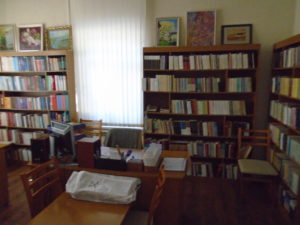
So we journeyed to their small capital, Comrad to visit a museum about this curious minority’s history. We were dropped off at the Parliament building and spotted a library on the other side of the road. The library was open, so the dozen of us went inside, and Victoria went to ask the librarian if it was okay for us to visit. She came out and welcomed us, speaking Russian (another of Victoria’s languages), and explained that the Gagauz language was fairly similar to modern Turkish in everyday words but somewhat different in more technical areas. As could be seen from the signs, there was a sizeable collection of books and periodicals in both Gaguiz and Turkish. The Turkish Government provides financial support – a fact easily deduced from the prominent section devoted to Kemal Ataturk, but the library is open to everyone.
The library had an impressive reference collection, and –again I doubt you will be able to see this in the photo – even had at least one Agatha Christie!
The Librarian then read aloud a poem in the local language from an anthology. As many of our group had visited Turkey on holiday, the similarity of the sounds was evident. Victoria then thanked the librarian and we moved on, having all been fascinated by the library and the successful attempts to keep the language alive.
